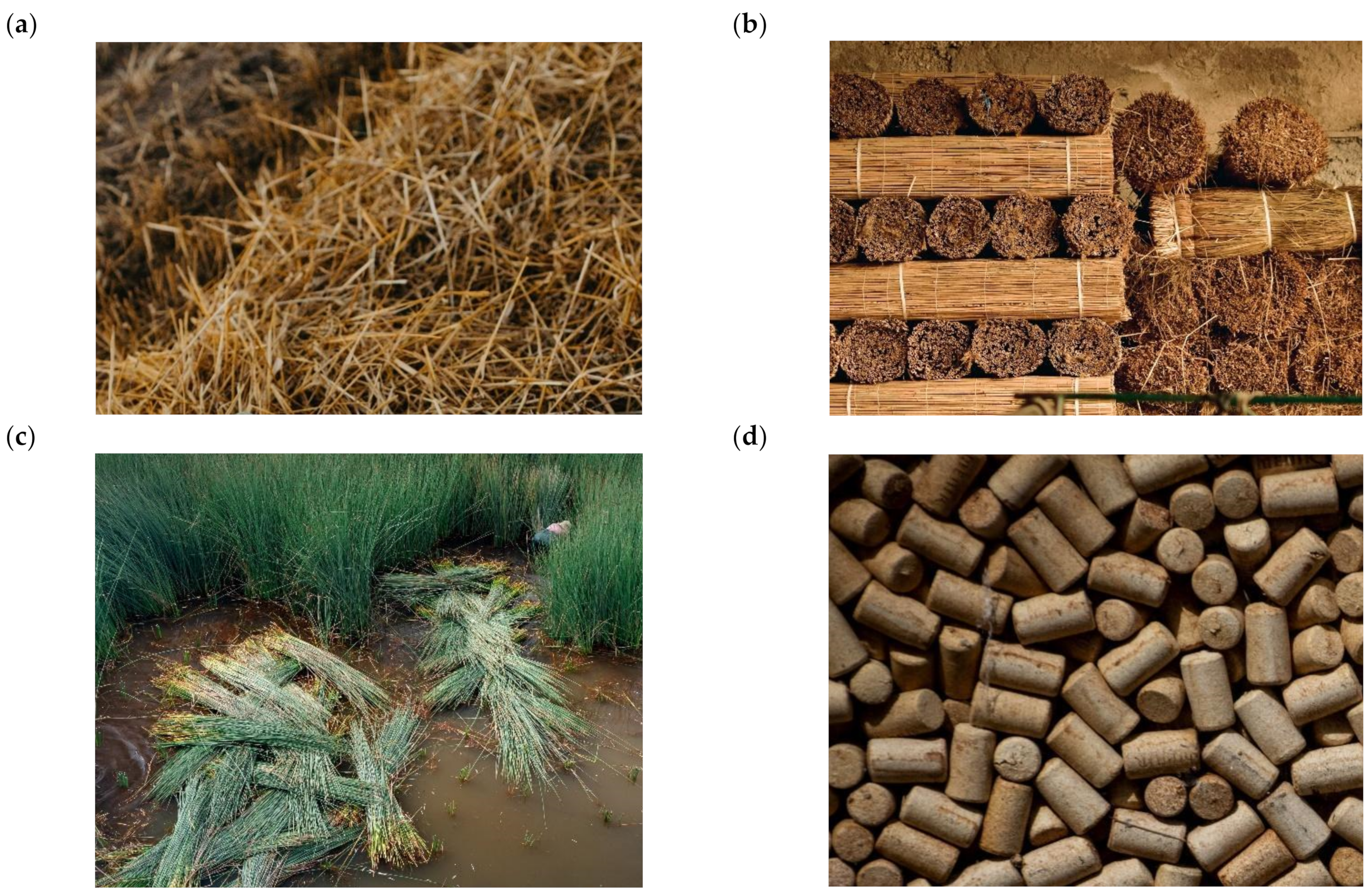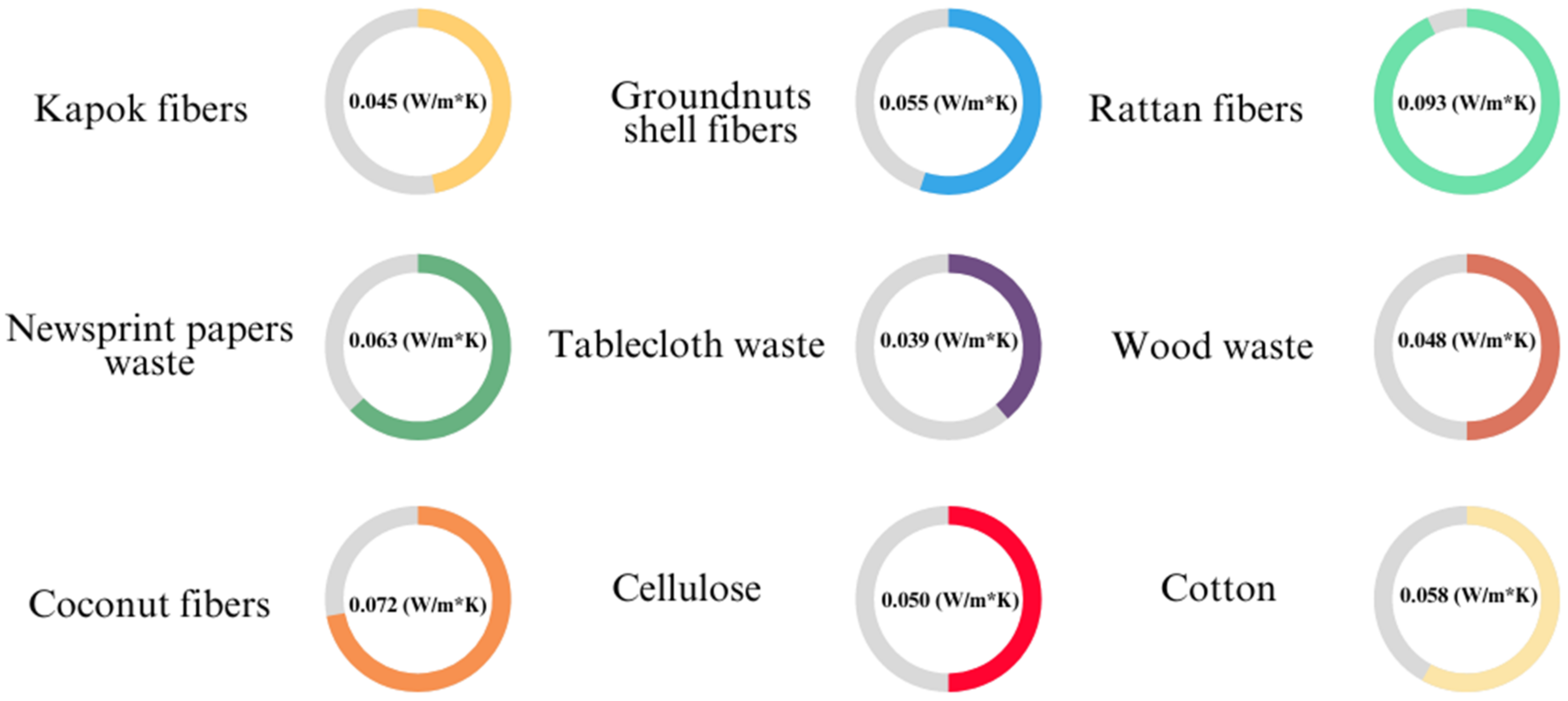New Resources for Sustainable Thermal Insulation Using Textile and Agricultural Waste in a New Circular Economy Approach: An Overview
Abstract
:1. Introduction
2. Challenge
3. Insulation Materials
3.1. Organic Thermal Insulators
- ✓
- Less energy required for the production of building components as well as the control indoor environmental temperature;
- ✓
- Less environmental consequences during the use and disposal phases;
- ✓
- CO2 environmental capture [1].
3.2. Thermal Insulators from Waste Materials
| Insulating Materials | Potential Application | References | |
|---|---|---|---|
| Industrial waste | Cardboard-based panels with recycled cardboard from packaging; Composite of onion skin and peanut shell fibers; Rice husk; Composite of cotton waste; Wood processing by-products waste. | Floors and ceilings; Unfinished walls; Construction walls, ceilings, floors, and roofs for new construction; Enclosed existing wall or open new wall cavities; places requiring insulation that can withstand high temperatures | [2,3,6,7,9,26] |
| Recycled waste agriculture straw | Maize husk after separation of the corn; Recycled concrete with cores of textile waste; Recycled cardboard based panels; Textile fiber waste; Cellulose sound absorbers produced by using extracted cellulose from recycled paper; Maize cob; Coconut pith with groundnut shell Sheep’s waste wool; Sunflower stalks; Corn peel; Wheat straw board composed of coconut coir and durian peel; Kenaf binderless board; Bagasse after extracting sugar. | [3,8,9,13,18,26,30,32,33,34,35,36] |
4. End-of-Life Cycle
5. Conclusions
- ○
- They are readily recycled at the end of the building’s life cycle, which does not require much energy or labor, and the recycled material can be used in other applications, such as packaging, mixing it with cement to allow it to become lighter, etc. The most important consideration is that the environmental impact of discarded waste is less than that of other building materials.
- ○
- These materials are biodegradable and can be used to produce bioenergy and as biofertilizer for plants to improve their growth and/or in agriculture; they are a suitable material to improve the performance of cultivated soils, especially by improving air renewal and moisture control.
Author Contributions
Funding
Institutional Review Board Statement
Informed Consent Statement
Data Availability Statement
Conflicts of Interest
Nomenclature
| Nomenclature | Property |
| EC | European Commission |
| EPS | Expanded polystyrene |
| EU | European Union |
| MW | Mineral wool |
| PUR | Polyurethane elastomer |
| W/m·K | Watt per meter-Kelvin (thermal conductivity unit) |
| XPS | Extruded polystyrene |
References
- Barreca, F.; Martinez, A.; Flores, J.A.; Pastor, J.J. Innovative use of giant reed and cork residues for panels of buildings in Mediterranean area. Resour. Conserv. Recycl. 2019, 140, 259–266. [Google Scholar] [CrossRef]
- Silvestre, J.D.; Pargana, N.; Brito, J.; De Pinheiro, M.D.; Durão, V. Insulation Cork Boards—Environmental Life Cycle Assessment of an Organic Construction Material. Materials 2016, 9, 394. [Google Scholar] [CrossRef] [PubMed]
- Abu-jdayil, B.; Mourad, A.; Hittini, W.; Hassan, M.; Hameedi, S. Traditional, state-of-the-art and renewable thermal building insulation materials: An overview. Constr. Build. Mater. 2016, 214, 709–735. [Google Scholar] [CrossRef]
- Duong, L.; Anh, H. An overview of factors influencing thermal conductivity of building insulation materials. J. Build. Eng. 2021, 44, 102604. [Google Scholar] [CrossRef]
- Palumbo, M.; Avellaneda, J.; Lacasta, A.M. Availability of crop by-products in Spain: New raw materials for natural thermal insulation. Resour. Conserv. Recycl. 2015, 99, 1–6. [Google Scholar] [CrossRef]
- Bakatovich, A.; Gaspar, F. Composite material for thermal insulation based on moss raw material. Constr. Build. Mater. 2019, 228, 116699. [Google Scholar] [CrossRef]
- Aditya, L.; Mahlia, T.M.I.; Rismanchi, B.; Ng, H.M.; Hasan, M.H.; Metselaar, H.S.C.; Muraza, O.; Aditiya, H.B. A review on insulation materials for energy conservation in buildings. Renew. Sustain. Energy Rev. 2017, 73, 1352–1365. [Google Scholar] [CrossRef]
- Agoudjil, B.; Benchabane, A.; Boudenne, A.; Ibos, L.; Fois, M. Renewable materials to reduce building heat loss: Characterization of date palm wood. Energy Build. 2011, 43, 491–497. [Google Scholar] [CrossRef]
- Dikmen, N.; Ozkan, S.T.E. Unconventional Insulation Materials; IntechOpen: London, UK, 2016. [Google Scholar]
- Briga-sá, A.; Nascimento, D.; Teixeira, N.; Pinto, J.; Caldeira, F.; Varum, H.; Paiva, A. Textile waste as an alternative thermal insulation building material solution. Constr. Build. Mater. 2013, 38, 155–160. [Google Scholar] [CrossRef]
- Hill, C.; Norton, A.; Dibdiakova, J. A comparison of the environmental impacts of different categories of insulation materials. Energy Build. 2018, 162, 12–20. [Google Scholar] [CrossRef]
- Biyada, S.; Merzouki, M.; Imtara, H.; Alajmi, M.F.; Elkarrach, K.; Mechchate, H.; Conte, R.; Benlemlih, M. Advanced Characterization of Organic Matter Decaying during Composting of Industrial Waste Using Spectral Methods. Processes 2021, 9, 1364. [Google Scholar] [CrossRef]
- Muthuraj, R.; Lacoste, C.; Lacroix, P.; Bergeret, A. Sustainable thermal insulation biocomposites from rice husk, wheat husk, wood fibers and textile waste fibers: Elaboration and performances evaluation. Ind. Crops Prod. 2019, 135, 238–245. [Google Scholar] [CrossRef]
- Wazna, M.; El Fatihi, M.; El Bouari, A.; El Cherkaoui, O. Thermo physical characterization of sustainable insulation materials made from textile waste. J. Build. Eng. 2017, 12, 196–201. [Google Scholar] [CrossRef]
- Llantoy, N.; Chàfer, M.; Cabeza, L.F. A comparative life cycle assessment (LCA) of different insulation materials for buildings in the continental Mediterranean climate. Energy Build. 2020, 225, 110323. [Google Scholar] [CrossRef]
- Hadded, A.; Benltoufa, S.; Jemni, A. Thermo physical characterization of recycled textile materials used for building insulating. J. Build. Eng. 2015, 5, 34–40. [Google Scholar] [CrossRef]
- Zach, J.; Hroudová, J.; Korjenic, A. Environmentally efficient thermal and acoustic insulation based on natural and waste fibers †. J. Chem. Technol. Biotechnol. 2016, 91, 2156–2161. [Google Scholar] [CrossRef]
- Silvestre, J.D.; De Brito, J.; Pinheiro, M.D. Life-Cycle Assessment of Thermal Insulation Materials for External Walls of Buildings; InspectApedia: New York, NY, USA, 2011. [Google Scholar]
- Cetiner, I.; Shea, A.D. Wood waste as an alternative thermal insulation for buildings. Energy Build. J. 2018, 168, 374–384. [Google Scholar] [CrossRef]
- Väisänen, T.; Haapala, A.; Lappalainen, R.; Tomppo, L. Utilization of agricultural and forest industry waste and residues in natural fiber-polymer composites: A review. Waste Manag. 2016, 54, 62–73. [Google Scholar] [CrossRef]
- Chopra, S.S.; Dong, L.; Kaur, G.; Len, C.; Sze, C.; Lin, K. Sustainable process design for circular fashion: Advances in sustainable chemistry for textile waste valorisation. Curr. Opin. Green Sustain. Chem. 2023, 39, 100747. [Google Scholar] [CrossRef]
- Khairul, M.; Nasrin, U.; Islam, M. Textile-apparel manufacturing and material waste management in the circular economy: A conceptual model to achieve sustainable development goal (SDG) 12 for Bangladesh. Clean. Environ. Syst. 2022, 4, 100070. [Google Scholar] [CrossRef]
- Piribauer, B.; Bartl, A. Textile recycling processes, state of the art and current developments: A mini review. Waste Manag. Res. 2019, 37, 112–119. [Google Scholar] [CrossRef] [PubMed]
- Zhang, H.N.D.; Zhang, Z. The use of hemp fibres as reinforcements in composites. Biofiber Reinf. Compos. Mater. 2015, 86–103. [Google Scholar] [CrossRef]
- Schumacher, K.A.; Forster, A.L. Textiles in a circular economy: An assessment of the current landscape, challenges, and opportunities in the United States. Front. Sustain. 2022, 3, 146. [Google Scholar] [CrossRef]
- Massoudinejad, M.; Amanidaz, N.; Santos, R.M.; Bakhshoodeh, R. Use of municipal, agricultural, industrial, construction and demolition waste in thermal and sound building insulation materials: A review article. J. Environ. Health Sci. Eng. 2019, 17, 1227–1242. [Google Scholar] [CrossRef] [PubMed]
- Broda, J.; Kobiela-mendrek, K.; Binia, D.; Rom, M.; Grzybowska-pietras, J.; Laszczak, R. Biodegradation of sheep wool geotextiles. Int. Biodeterior. Biodegrad. 2016, 115, 31–38. [Google Scholar] [CrossRef]
- Petek, B.; Marinšek, R. Management of waste sheep wool as valuable organic substrate in European Union countries. J. Mater. Cycles Waste Manag. 2020, 23, 44–54. [Google Scholar] [CrossRef]
- Vasiliauskiene, D.; Balciunas, G.; Boris, R.; Kairyte, A.; Urbonavicius, J. The Effect of Different Plant Oil Impregnation and Hardening Temperatures on Physical-Mechanical Properties of Modified Biocomposite Boards Made of Hemp Shives and Corn Starch. Materials 2020, 13, 5275. [Google Scholar] [CrossRef]
- Pinto, J.; Paiva, A.; Varum, H.; Costa, A.; Cruz, D.; Pereira, S.; Fernandes, L.; Tavares, P.; Agarwal, J. Corn’s cob as a potential ecological thermal insulation material. Energy Build. 2011, 43, 1985–1990. [Google Scholar] [CrossRef]
- Lavoinea, N.; Bergströma, L. Nanocellulose-based foams and aerogels: Processing, properties, and applications. J. Mater. Chem. A 2017, 5, 16105–16117. [Google Scholar] [CrossRef]
- Binici, H.; Eken, M.; Kara, M. An environment-friendly thermal insulation material from sunflower stalk, textile waste and stubble fibers. Constr. Build. Mater. 2013, 51, 20–23. [Google Scholar] [CrossRef]
- Fakhfakh, N.; Ktari, N.; Siala, R.; Nasri, M. Wool-waste valorization: Production of protein hydrolysate with high antioxidative potential by fermentation with a new keratinolytic bacterium, Bacillus pumilus A1. J. Appl. Microbiol. 2013, 115, 424–433. [Google Scholar] [CrossRef] [PubMed]
- Johnson, B.S.; Echeverria, D.; Venditti, R.; Jameel, H.; Yao, Y.; Carolina, N. Supply Chain of Waste Cotton Recycling and Reuse: A Review. AATCC J. Res. 2020, 7, 19–31. [Google Scholar] [CrossRef]
- Patnaik, A.; Mvubu, M.; Muniyasamy, S.; Botha, A.; Anandjiwala, R.D. Thermal and sound insulation materials from waste wool and recycled polyester fibers and their biodegradation studies. Energy Build. 2015, 92, 161–169. [Google Scholar] [CrossRef]
- Norhisham, D.A.; Saad, N.M.; Ahmad Usuldin, S.R.; Vayabari, D.A.G.; Ilham, Z.; Ibrahim, M.F.; Wan-Mohtar, W.A.A.Q.I. Bioactivities of Kenaf Biomass Extracts: A Review. Processes 2023, 11, 1178. [Google Scholar] [CrossRef]
- Pargana, N.; Duarte, M.; Dinis, J.; De Brito, J. Comparative environmental life cycle assessment of thermal insulation materials of buildings. Energy Build. 2014, 82, 466–481. [Google Scholar] [CrossRef]
- Santhosh, J.; Sarkar, O.; Mohan, S.V. Green Hydrogen-Compressed natural gas (bio-H-CNG) production from food waste: Organic load influence on hydrogen and methane fusion. Bioresour. Technol. 2021, 340, 125643. [Google Scholar] [CrossRef] [PubMed]
- Biyada, S.; Merzouki, M.; Demcenko, T.; Vasiliauskiene, D.; Marciulaitiene, E.; Vasarevicius, S.; Urbonavicius, J. The Effect of Feedstock Concentration on the Microbial Community Dynamics during Textile Waste Composting. Front. Ecol. Evol. 2022, 10, 813488. [Google Scholar] [CrossRef]
- Biyada, S.; Imtara, H.; Elkarrach, K.; Laidi, O.; Saleh, A. Bio-Augmentation as an Emerging Strategy to Improve the Textile Compost Quality Using Identified Autochthonous Strains. Appl. Sci. 2022, 12, 3160. [Google Scholar] [CrossRef]
- Czeka, W.; Nowak, M.; Piechota, G. Sustainable management and recycling of anaerobic digestate solid fraction by composting: A review. Bioresour. Technol. 2023, 375, 128813. [Google Scholar] [CrossRef]
- Ribul, M.; Lanot, A.; Tommencioni, C.; Purnell, P.; Mcqueen-mason, S.J.; Baurley, S. Mechanical, chemical, biological: Moving towards closed-loop bio-based recycling in a circular economy of sustainable textiles. J. Clean. Prod. 2021, 326, 129325. [Google Scholar] [CrossRef]



Disclaimer/Publisher’s Note: The statements, opinions and data contained in all publications are solely those of the individual author(s) and contributor(s) and not of MDPI and/or the editor(s). MDPI and/or the editor(s) disclaim responsibility for any injury to people or property resulting from any ideas, methods, instructions or products referred to in the content. |
© 2023 by the authors. Licensee MDPI, Basel, Switzerland. This article is an open access article distributed under the terms and conditions of the Creative Commons Attribution (CC BY) license (https://creativecommons.org/licenses/by/4.0/).
Share and Cite
Biyada, S.; Merzouki, M.; Urbonavičius, J. New Resources for Sustainable Thermal Insulation Using Textile and Agricultural Waste in a New Circular Economy Approach: An Overview. Processes 2023, 11, 2683. https://doi.org/10.3390/pr11092683
Biyada S, Merzouki M, Urbonavičius J. New Resources for Sustainable Thermal Insulation Using Textile and Agricultural Waste in a New Circular Economy Approach: An Overview. Processes. 2023; 11(9):2683. https://doi.org/10.3390/pr11092683
Chicago/Turabian StyleBiyada, Saloua, Mohammed Merzouki, and Jaunius Urbonavičius. 2023. "New Resources for Sustainable Thermal Insulation Using Textile and Agricultural Waste in a New Circular Economy Approach: An Overview" Processes 11, no. 9: 2683. https://doi.org/10.3390/pr11092683
APA StyleBiyada, S., Merzouki, M., & Urbonavičius, J. (2023). New Resources for Sustainable Thermal Insulation Using Textile and Agricultural Waste in a New Circular Economy Approach: An Overview. Processes, 11(9), 2683. https://doi.org/10.3390/pr11092683









